

George Washington: The Living Symbol. Activity 1.

George Washington, as a living symbol Ask students about George Washington's role in American culture, as both a historical individual and as a national symbol. What do we represent with his image? What do we commemorate with his name? Activity 2. From Enemy to Ally (John Bull and Uncle Sam) From Revolution to Reconstruction: Essays: The Stamp Act and the Sugar Act: Background and Reasons for Resistance (2/4) The Sugar Act caused alarm in the American colonies, partly because of the expected economic disadvantages, but also because of a number of other reasons, one of the most important being the severe implementation by the navy.

Added to this was a general post-war depression and the enactment of another act prohibiting the use of paper money as legal tender, almost immediately following the Sugar Act. From Revolution to Reconstruction: Essays: The battle of lexington: The Battle of Lexington. Introduction For a map of the USA in 1775 click here The British were to find that 1775 was to be a disastrous year.
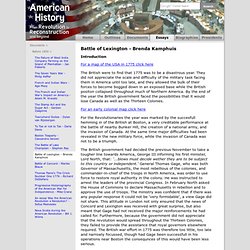
From revolution to reconstruction: Essays: Boston Teaparty: Boston Teaparty. In 1773, Britain's East India Company was sitting on large stocks of tea that it could not sell in England.

It was on the verge of bankruptcy. In an effort to save it, the government passed the Tea Act of 1773, which gave the company the right to export its merchandise directly to the colonies without paying any of the regular taxes that were imposed on the colonial merchants, who had traditionally served as the middlemen in such transactions. With these privileges, the company could undersell American merchants and monopolize the colonial tea trade. The act proved inflammatory for several reasons. First, it angered influential colonial merchants, who feared being replaced and bankrupted by a powerful monopoly. Various colonies made plans to prevent the East India Company from landing its cargoes in colonial ports. From Revolution to Reconstruction: Essays: Thomas Paine's The Crisis, Number One, 1776: Thomas Paine's The Crisis, Number One, 1776.
After the colonists in America decided that they were going to attempt a move towards freedom from British rule, they found themselves faced with several problems.
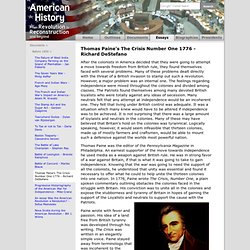
Many of these problems dealt directly with the threat of a British invasion to stamp out such a revolution. However, a major problem was an internal one. The feelings regarding independence were mixed throughout the colonies and divided among classes. The Patriots found themselves among many devoted British loyalists who were totally against any ideas of secession. Many neutrals felt that any attempt at independence would be an incoherent one. Digital History. The American Revolution (John Bull and Uncle Sam) Some scholars have argued that economics and class conflicts caused the American Revolution.
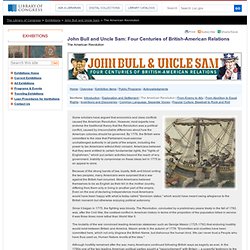
However, most experts now endorse the traditional theory that the Revolution was a political conflict, caused by irreconcilable differences about how the American colonies should be governed. By 1776, the British were committed to the view that Parliament must exercise unchallenged authority in all parts of the empire, including the power to tax Americans without their consent. Americans believed that they were entitled to certain fundamental rights, the "rights of Englishmen," which put certain activities beyond the reach of any government. Inability to compromise on these ideas led in 1775 to an appeal to arms. 58uc.jpg (1024×736) From Revolution to Reconstruction: Documents: Causes and Necessity of taking up Arms. When the second Continental Congress convened in May 1775, the battles of Lexington and Concord had already been fought, and an informally organised American army was besieging General Gage's troops in Boston.
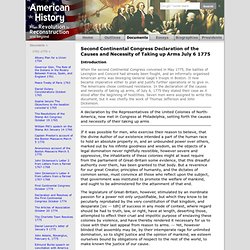
It now became imperative either to plan and justify further operations or to give in. The Americans chose continued resistance. Print culture. Print culture embodies all forms of printed text and other printed forms of visual communication.

One prominent scholar in the field is Elizabeth Eisenstein, who contrasted print culture, which appeared in Europe in the centuries after the advent of the Western printing-press (and much earlier in China where woodblock printing was used from at least 800 AD), to scribal culture. Walter Ong, by contrast, has contrasted written culture, including scribal, to oral culture. Ong is generally considered one of the first scholars to define print culture in contrast to oral culture. These views are related as the printing press brought a vast rise in literacy, so that one of its effects was simply the great expansion of written culture at the expense of oral culture. LIBERTY! . Chronicle of the Revolution. From Revolution to Reconstruction: Documents: Paine: Common Sense Index IV. IN the following pages I offer nothing more than simple facts, plain arguments, and common sense; and have no other preliminaries to settle with the reader, than that he will divest himself of prejudice and prepossession, and suffer his reason and his feelings to determine for themselves; that he will put on, or rather that he will not put off, the true character of a man, and generously enlarge his views beyond the present day.

Africans in America/Part 2/Felix's Petition. Deism and the Founding of the United States, Divining America, TeacherServe®, National Humanities Center. America as a Religious Refuge: the 17th Century (Religion and the Founding of the American Republic, Library of Congress Exhibition) Many of the British North American colonies that eventually formed the United States of America were settled in the seventeenth century by men and women, who, in the face of European persecution, refused to compromise passionately held religious convictions and fled Europe.
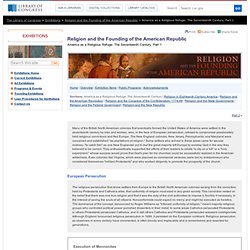
The New England colonies, New Jersey, Pennsylvania, and Maryland were conceived and established "as plantations of religion. " Some settlers who arrived in these areas came for secular motives--"to catch fish" as one New Englander put it--but the great majority left Europe to worship God in the way they believed to be correct. They enthusiastically supported the efforts of their leaders to create "a city on a hill" or a "holy experiment," whose success would prove that God's plan for his churches could be successfully realized in the American wilderness.
European Persecution Execution of Mennonites Murder of David van der Leyen and Levina Ghyselins, Ghent, 1554. A Jesuit Disemboweled. Thomas Paine 2/7. SOME writers have so confounded society with government, as to leave little or no distinction between them; whereas they are not only different, but have different origins. Society is produced by our wants, and government by our wickedness; the former promotes our happiness Positively by uniting our affections, the latter negatively by restraining our vices.
The one encourages intercourse, the other creates distinctions. The first is a patron, the last a punisher. Society in every state is a blessing, but government even in its best state is but a necessary evil in its worst state an in tolerable one; for when we suffer, or are exposed to the same miseries by a government, which we might expect in a country without government, our calamities is heightened by reflecting that we furnish the means by which we suffer! Religion and the American Revolution (Religion and the Founding of the American Republic, Library of Congress Exhibition) Religion played a major role in the American Revolution by offering a moral sanction for opposition to the British--an assurance to the average American that revolution was justified in the sight of God.
As a recent scholar has observed, "by turning colonial resistance into a righteous cause, and by crying the message to all ranks in all parts of the colonies, ministers did the work of secular radicalism and did it better. " Ministers served the American cause in many capacities during the Revolution: as military chaplains, as penmen for committees of correspondence, and as members of state legislatures, constitutional conventions and the national Congress. Some even took up arms, leading Continental troops in battle. The Declaration of Independence. Conflict over Ratifying the Constitution. Impact of the Revolution.
Religion, Race, and Gender. Towards Revolution - Primary Sources. Why Should We Care about the American Revolution? Interactive Map of Revolutionary War Sites. Other Lessons. Revolutionary War Timeline. Education in the Revolutionary Era. Section II - American Education Part 2 Education in the Revolutionary Era As the American colonies continued to grow and prosper, the European traditions that had previously guided the development of schools and education began to lose some of their influence. Though religion was still an important part of the curriculum, the need to build and maintain commerce, agriculture and shipping interests required a different focus. As generations were born and grew up in the American colonies, people began to see themselves as apart from their European roots and started to develop their own identity. The American Revolution was the culmination of this movement away from the European traditions and resulted in independence for the thirteen colonies from Great Britain.
Benjamin Franklin (1706-1790) was a Renaissance man who had a profound influence in many different areas. Females for the most part received little or no formal education during the 17th and 18th centuries. Revolutionary War App.